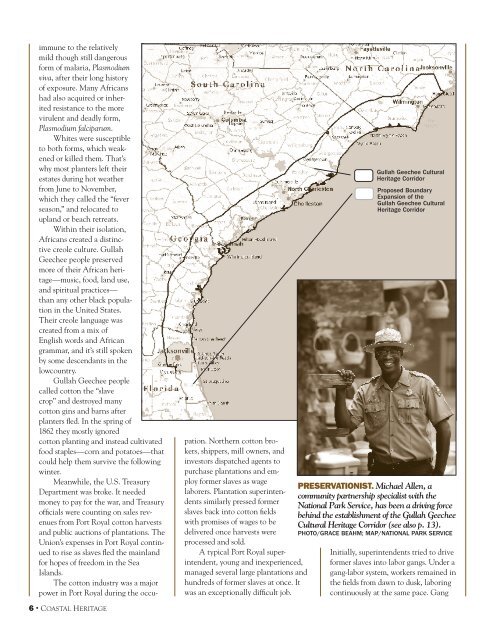Coastal Heritage magazine - Fall 2012 - SC Sea Grant Consortium
Coastal Heritage magazine - Fall 2012 - SC Sea Grant Consortium
Coastal Heritage magazine - Fall 2012 - SC Sea Grant Consortium
You also want an ePaper? Increase the reach of your titles
YUMPU automatically turns print PDFs into web optimized ePapers that Google loves.
immune to the relatively<br />
mild though still dangerous<br />
form of malaria, Plasmodium<br />
viva, after their long history<br />
of exposure. Many Africans<br />
had also acquired or inherited<br />
resistance to the more<br />
virulent and deadly form,<br />
Plasmodium falciparum.<br />
Whites were susceptible<br />
to both forms, which weakened<br />
or killed them. That’s<br />
why most planters left their<br />
estates during hot weather<br />
from June to November,<br />
which they called the “fever<br />
season,” and relocated to<br />
upland or beach retreats.<br />
Within their isolation,<br />
Africans created a distinctive<br />
creole culture. Gullah<br />
Geechee people preserved<br />
more of their African heritage—music,<br />
food, land use,<br />
and spiritual practices—<br />
than any other black population<br />
in the United States.<br />
Their creole language was<br />
created from a mix of<br />
English words and African<br />
grammar, and it’s still spoken<br />
by some descendants in the<br />
lowcountry.<br />
Gullah Geechee people<br />
called cotton the “slave<br />
crop” and destroyed many<br />
cotton gins and barns after<br />
planters fled. In the spring of<br />
1862 they mostly ignored<br />
cotton planting and instead cultivated<br />
food staples—corn and potatoes—that<br />
could help them survive the following<br />
winter.<br />
Meanwhile, the U.S. Treasury<br />
Department was broke. It needed<br />
money to pay for the war, and Treasury<br />
officials were counting on sales revenues<br />
from Port Royal cotton harvests<br />
and public auctions of plantations. The<br />
Union’s expenses in Port Royal continued<br />
to rise as slaves fled the mainland<br />
for hopes of freedom in the <strong>Sea</strong><br />
Islands.<br />
The cotton industry was a major<br />
power in Port Royal during the occu-<br />
6 • <strong>Coastal</strong> <strong>Heritage</strong><br />
pation. Northern cotton brokers,<br />
shippers, mill owners, and<br />
investors dispatched agents to<br />
purchase plantations and employ<br />
former slaves as wage<br />
laborers. Plantation superintendents<br />
similarly pressed former<br />
slaves back into cotton fields<br />
with promises of wages to be<br />
delivered once harvests were<br />
processed and sold.<br />
A typical Port Royal superintendent,<br />
young and inexperienced,<br />
managed several large plantations and<br />
hundreds of former slaves at once. It<br />
was an exceptionally difficult job.<br />
Gullah Geechee Cultural<br />
<strong>Heritage</strong> Corridor<br />
Proposed Boundary<br />
Expansion of the<br />
Gullah Geechee Cultural<br />
<strong>Heritage</strong> Corridor<br />
PRESERVATIONIST. Michael Allen, a<br />
community partnership specialist with the<br />
National Park Service, has been a driving force<br />
behind the establishment of the Gullah Geechee<br />
Cultural <strong>Heritage</strong> Corridor (see also p. 13).<br />
PHOTO/GRACE BEAHM; MAP/NATIONAL PARK SERVICE<br />
Initially, superintendents tried to drive<br />
former slaves into labor gangs. Under a<br />
gang-labor system, workers remained in<br />
the fields from dawn to dusk, laboring<br />
continuously at the same pace. Gang


